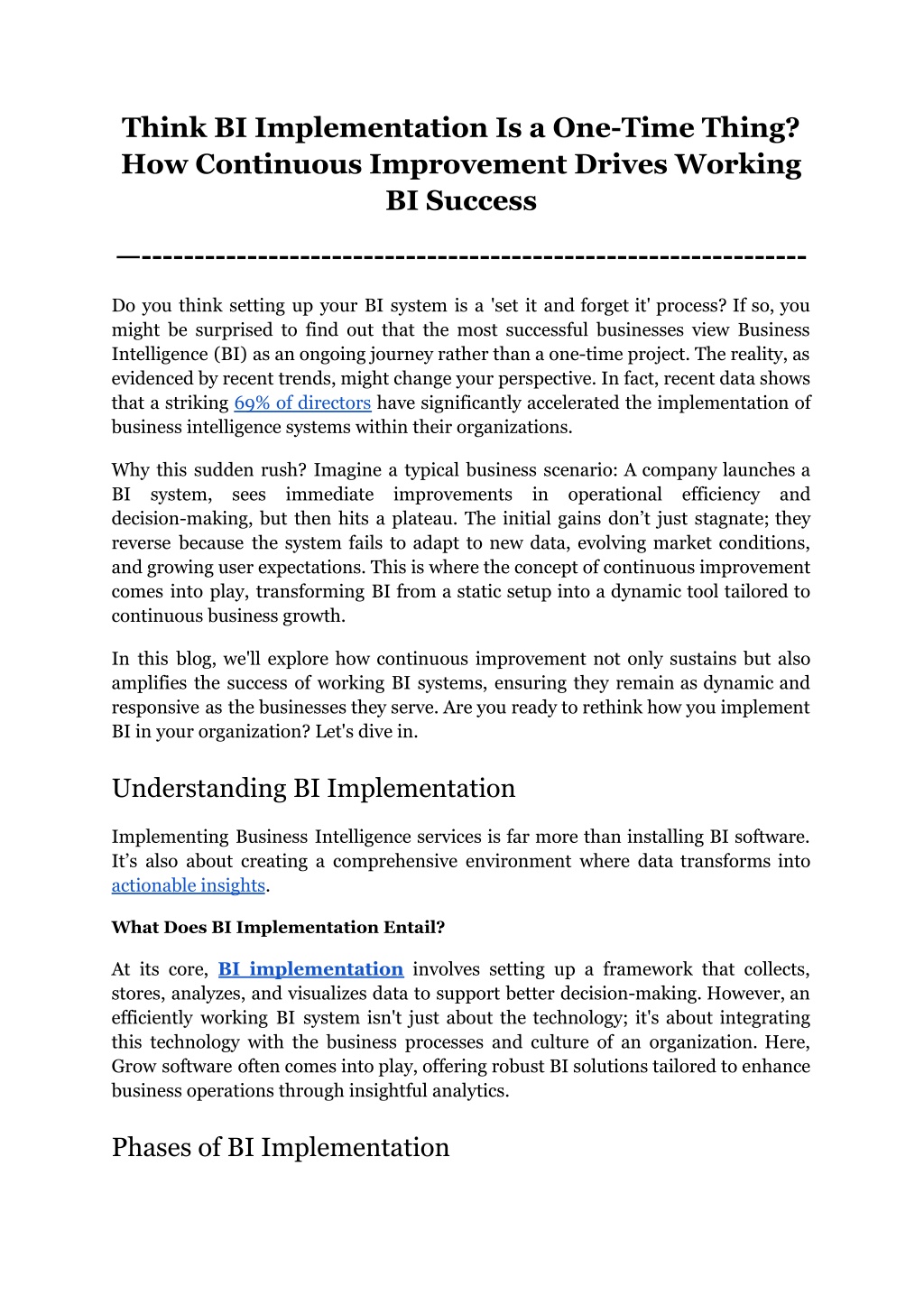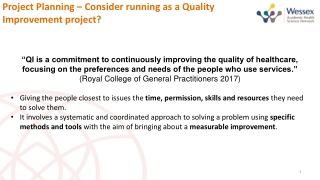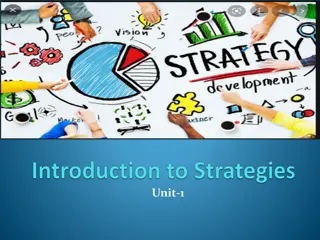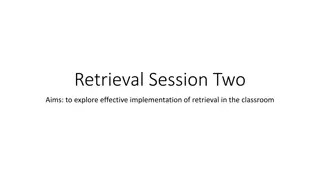
Think BI Implementation Is a One-Time Thing_ How Continuous Improvement Drives Working BI Success
Discover why treating Business Intelligence (BI) implementation as a one-time project can limit its potential in our latest blog. We explore how continuous improvement is essential for maintaining the effectiveness and relevance of working BI systems, ensuring they adapt and grow with your business needs.
Download Presentation
Please find below an Image/Link to download the presentation.
The content on the website is provided AS IS for your information and personal use only. It may not be sold, licensed, or shared on other websites without obtaining consent from the author. Download presentation by click this link. If you encounter any issues during the download, it is possible that the publisher has removed the file from their server.
Presentation Transcript
Think BI Implementation Is a One-Time Thing? How Continuous Improvement Drives Working BI Success --------------------------------------------------------------- Do you think setting up your BI system is a 'set it and forget it' process? If so, you might be surprised to find out that the most successful businesses view Business Intelligence (BI) as an ongoing journey rather than a one-time project. The reality, as evidenced by recent trends, might change your perspective. In fact, recent data shows that a striking 69% of directors have significantly accelerated the implementation of business intelligence systems within their organizations. Why this sudden rush? Imagine a typical business scenario: A company launches a BI system, sees immediate improvements decision-making, but then hits a plateau. The initial gains don t just stagnate; they reverse because the system fails to adapt to new data, evolving market conditions, and growing user expectations. This is where the concept of continuous improvement comes into play, transforming BI from a static setup into a dynamic tool tailored to continuous business growth. in operational efficiency and In this blog, we'll explore how continuous improvement not only sustains but also amplifies the success of working BI systems, ensuring they remain as dynamic and responsive as the businesses they serve. Are you ready to rethink how you implement BI in your organization? Let's dive in. Understanding BI Implementation Implementing Business Intelligence services is far more than installing BI software. It s also about creating a comprehensive environment where data transforms into actionable insights. What Does BI Implementation Entail? At its core, BI implementation involves setting up a framework that collects, stores, analyzes, and visualizes data to support better decision-making. However, an efficiently working BI system isn't just about the technology; it's about integrating this technology with the business processes and culture of an organization. Here, Grow software often comes into play, offering robust BI solutions tailored to enhance business operations through insightful analytics. Phases of BI Implementation
1. Initial Assessment: Before introducing any BI software, it's crucial to conduct a thorough needs assessment. This phase should involve important stakeholders and be in accordance with the organization's strategic goals. The aim is to understand the specific data needs, the existing data infrastructure, implementing Business Intelligence services. This assessment helps in designing a perfectly working BI strategy that aligns with the business objectives. and the expected outcomes from 2. Development and Customization: Based on the initial assessment, the next step is developing and customizing the BI solution to fit the organization's needs. This involves configuring the BI software, like Grow software, to handle data sources with over a hundred connectors appropriately, ensuring data quality, and setting up dashboards and reports tailored to user requirements. Customization is critical because it ensures that the working BI system reflects the unique aspects of the business and its operational dynamics. 3. Deployment: Deploying BI software involves more than just setting up the system. It includes integrating it into the existing IT infrastructure without disrupting ongoing operations. Effective deployment ensures that all data sources are connected, and the BI system communicates seamlessly with other business applications, enhancing the overall utility of the seamlessly working BI implementation. 4. User Training and Adoption: The success of a business intelligence system hinges on how well its end users can use it. Training and support are essential to ensure users can leverage the working BI tools effectively. Adoption also includes ongoing support and the establishment of a helpdesk to address any issues users face, making the BI tools part of the everyday workflow within the organization. Why Implementation Continuous Improvement Is Essential in BI 1. Dynamic Business Environments: Business environments and market conditions change rapidly. A BI system that remains static can quickly become obsolete, failing to provide the insights needed to make informed decisions. Continuous improvement helps ensure that BI systems evolve in response to changes in business conditions, regulatory environments, and industry trends. This adaptability is crucial for businesses to maintain a competitive edge. 2. Integrating New Technologies and Data Sources: As new technologies emerge and more data becomes available, BI systems need to integrate these 2
elements seamlessly into their operations. Continuous improvement in BI involves updating the system to handle new data types and sources, ensuring that the analytics continue to provide relevant and actionable insights. Grow software, known for its flexibility, facilitates this integration, making it easier for businesses to adapt to new technologies and data sources. 3. Enhancing User Experience and Adoption: User expectations and capabilities evolve over time. What was intuitive and efficient a year ago may not meet user needs today. Continuous improvement focuses on enhancing the user interface and usability of BI software, ensuring that it remains user-friendly and that new features are added to improve user experience. This not only helps in retaining user engagement but also ensures that the BI tools are used to their full potential. 4. Scalability and Performance Optimization: As the volume of data and the number of BI users increase, BI systems must scale accordingly without compromising performance. Both horizontal (adding more servers) and vertical (adding more powerful hardware) scalability are required for this. Additionally, techniques like in-memory computing and distributed processing can significantly improve query response times and computational efficiency. Continuous improvement practices also include regular performance benchmarking and tuning of the BI tools, such as optimizing SQL queries, indexing data appropriately, and employing cache management strategies to enhance the speed and responsiveness of BI dashboards. How Continuous Improvement Drives Working BI Success Strategies to Implement Continuous Improvement in BI 1. Establishing a Feedback-Driven Culture: For continuous improvement to be effective, it needs to be part of the organization's culture. Encouraging feedback from all users of the BI system, including data analysts, business managers, and IT staff, is crucial. This feedback should inform regular updates and improvements, ensuring that the Business Intelligence services aligns with user needs and business goals. Grow software facilitates such feedback loops through customizable dashboards and interactive reporting tools, making it easier for users to provide insights into their experiences and needs. 2. Regular Training and Upskilling: As BI tools evolve, so must the skills of those who use them. Continuous training and development programs ensure that employees are up-to-date with the latest features and capabilities of their BI software. Grow software supports this with online 3
tutorials, webinars, and user guides that are regularly updated to reflect new functionalities and best practices in BI. 3. Iterative Development Processes: Adopting an agile approach to the development and deployment of BI tools can significantly enhance the flexibility and responsiveness of BI services. This approach supports regular iterations based on user feedback and new business requirements, allowing for gradual enhancements that improve performance and functionality over time. 3. Modular Architecture and Microservices Transitioning BI systems to a modular architecture based on microservices can significantly facilitate continuous improvement. This approach allows different components of the working BI system, such as data ingestion, processing, and visualization, to be developed, updated, and scaled independently. Microservices architecture enhances the agility and resilience of BI systems, enabling rapid deployment of new features and easier management of complex systems. In the context of Business Intelligence services, utilizing microservices allows for the seamless integration of new data sources and analytical tools without disrupting existing operations. For instance, a new predictive analytics service can be added as a microservice to enhance forecasting capabilities without the need to overhaul the entire BI platform. 4. Advanced Data Integration Techniques Implementing data integration techniques such as Extract, Transform, Load (ETL), and more advanced Extract, Load, Transform (ELT) processes, supports the dynamic nature of data flows in modern enterprises. These techniques are crucial for consolidating disparate data sources into a cohesive BI system that provides consistent, reliable insights. The use of data integration platforms that support real-time data streaming and batch processing can improve the timeliness and accuracy of the data presented in BI dashboards. Advanced integration tools also often include data quality functions, ensuring that the data used in decision-making is clean and trustworthy. 3. Automated Testing and Quality Assurance Automated testing frameworks are essential for maintaining the reliability of BI systems through continuous improvement cycles. Automated regression testing, performance testing, and data validation can ensure that updates do not introduce errors or degrade the performance of the BI system. 4
In BI, automated testing should extend to data models and reports to ensure that they continue to meet user needs and maintain accuracy. Tools that can simulate user queries and generate reports automatically can be used to test the system under various scenarios, ensuring that all components function as expected before being deployed to live environments. 4. Continuous Deployment and Integration (CD/CI) Pipelines Implementing Continuous Deployment and Integration pipelines in BI environments facilitates the rapid and reliable rollout of new features and updates. These pipelines automate the steps from code commit to production deployment, including testing and quality checks, which speeds up development cycles and reduces the risk of human error. For BI systems, CD/CI pipelines can be configured to automatically update data models, algorithms, and dashboard components. This ensures that the latest business logic and data insights are always available to users, with minimal downtime and operational disruption. 5. User-Centric Design and Development Adopting a user-centric approach in the continuous improvement of BI systems ensures that the tools remain relevant and highly usable. This involves iterative design processes that incorporate user feedback directly into the development cycle through usability testing, A/B testing, and prototype evaluations. In BI, user-centric design means creating customizable and adaptable interfaces that cater to the varied needs of different user groups. Advanced visualization tools and interactive dashboards that users can modify to suit their specific analytical needs are examples of how BI systems can evolve to enhance user engagement and satisfaction. Conclusion The Continuous Journey of BI Implementation As we have explored throughout this discussion, the notion that BI implementation is a one-time event is a profound misconception. In reality, the success of Business Intelligence is driven by an ongoing commitment to refinement and evolution. To remain competitive, responsive, and effective, working BI systems must embrace continuous improvement as a core operational strategy. Software like Grow is a lifesaver in an ever-changing environment. Grow is not just a tool; it's a partner in your journey towards maintaining a robust, adaptable BI environment. Its intuitive design and powerful analytics capabilities are continually updated to meet the changing demands of businesses and industries, ensuring that your BI system grows alongside your company. 5
For those who are considering the leap into enhanced BI practices or looking to upgrade their current systems, taking advantage of Grow's 14-day free trial offers a risk-free opportunity to witness firsthand how continuous improvement can be seamlessly integrated into your BI strategy. Additionally, don't just take our word for it. Explore the experiences of those who have transformed their data into actionable insights with Grow. Visit "Grow Reviews from Verified Users on Capterra" to read real-world stories of success from a diverse array of industries. These testimonials not only underline the adaptability and efficiency of Grow software but also highlight the tangible benefits of embedding continuous improvement within your BI practices. Keep in mind that when it comes to Business Intelligence, being stagnant is the polar opposite of succeeding. With Grow, embark on a never-ending journey of improvement, where every piece of data and every user interaction enhances your strategic capabilities. Start your trial, read the reviews, and let Grow help you unlock the full potential of your data-driven endeavors. 6
















































